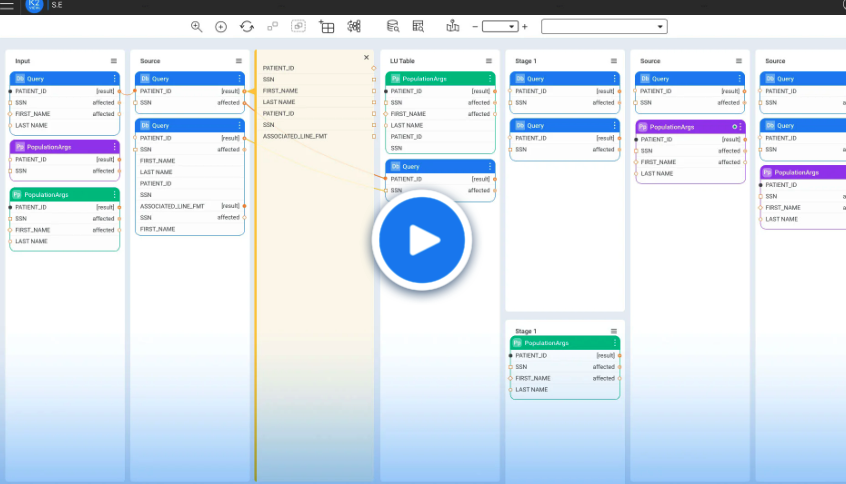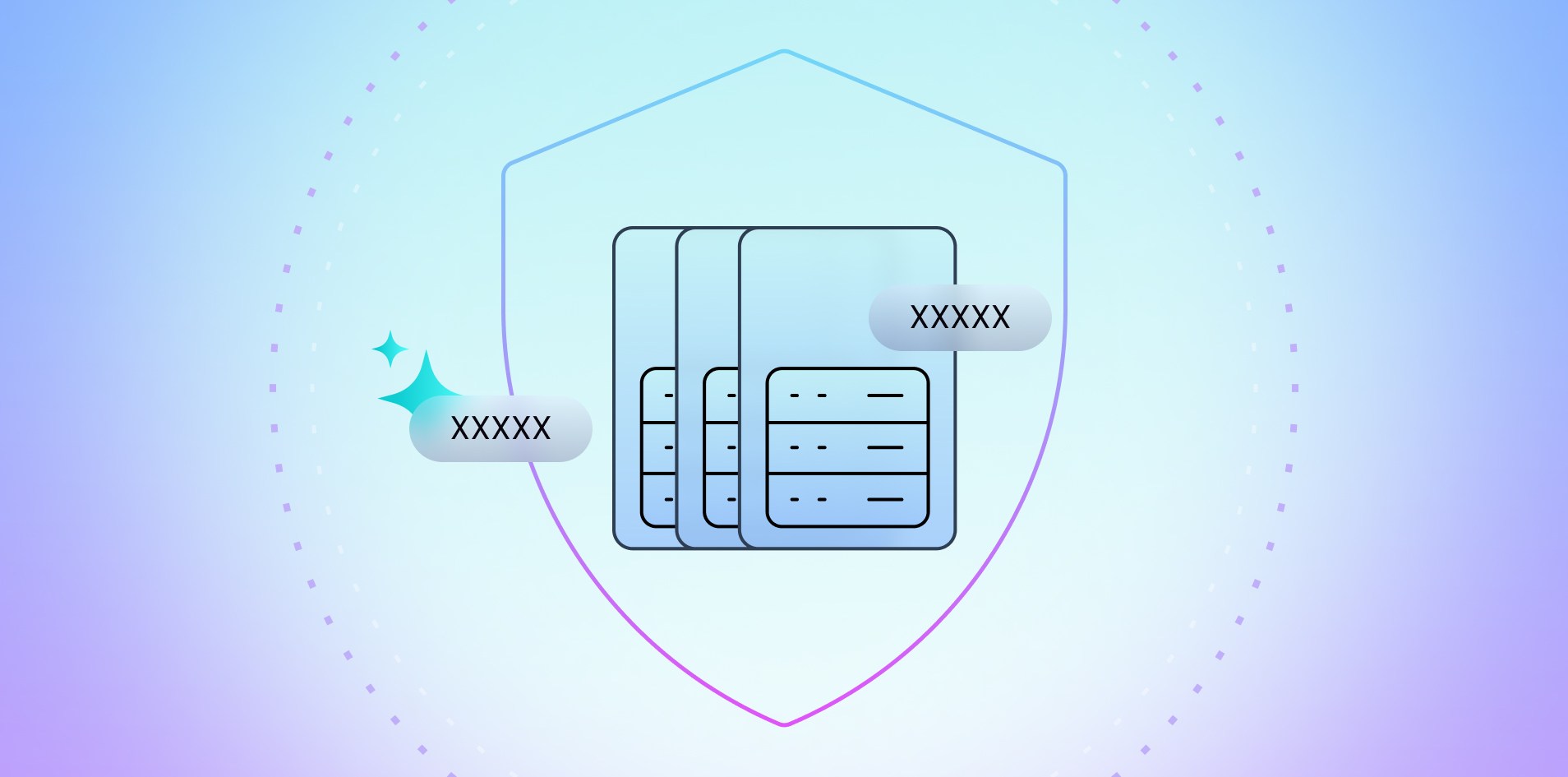Mainframe data masking protects PII and other sensitive data in legacy systems for software testing, analytics, GenAI data grounding, and B2B data sharing.
What is mainframe data masking?
Legacy mainframes continue to power critical business operations for enterprises, processing massive volumes of sensitive data daily. Despite their age, these systems house some of the most valuable and regulated information, making data masking essential for analytics, B2B data sharing, GenAI data grounding, and software testing,
Mainframe data masking has emerged as a crucial capability for organizations seeking to protect Personally Identifiable Information (PII), financial data, medical records, and other sensitive information while maintaining the operational integrity of their legacy systems.
The unique architecture and data formats of mainframe systems require specialized approaches to data masking that differ significantly from modern distributed environments. Understanding these requirements and implementing the appropriate masking strategy is essential for organizations, especially those in regulated industries where violations can result in severe penalties.
Mainframe data environments – DB2, IMS, VSAM, etc.
Mainframes operate with distinctive data structures and formats that present unique challenges for data protection initiatives. Unlike modern databases that use standard relational models, mainframe systems rely on various data storage methods including DB2 relational databases, IMS (Information Management System) hierarchical databases, VSAM (Virtual Storage Access Method) files, and sequential flat files.1
These legacy data formats often contain fixed-length records with packed decimal fields, EBCDIC encoding, and complex data relationships that must be preserved during the masking process. Additionally, mainframe applications frequently depend on specific data formats and referential integrity across multiple datasets – in both mainframe non-mainframe systems – making traditional data masking approaches inadequate for mainframe environments. This becomes even more important when masked mainframe data is replicated into cloud ecosystems, where Snowflake data masking and other controls help maintain consistent protection across hybrid architectures.
The challenge becomes more complex when considering that mainframes often feed data to distributed systems, data warehouses, and analytical platforms. Any data masking solution must therefore maintain consistency across the entire data ecosystem while masking sensitive data in:
-
Lower environments – for software testing
-
Data lakes and data warehouses – for analytics
-
The data pipeline – for data sharing
Mainframe compliance issues
Modern data privacy regulations such as GDPR, CCPA, HIPAA, and PCI-DSS apply equally to mainframe systems, despite their legacy status. Organizations cannot claim exemption from compliance requirements simply because their data resides on older systems. This creates significant challenges for enterprises that must demonstrate data protection capabilities across their entire technology stack.2
The regulatory landscape has evolved rapidly, with privacy laws becoming increasingly stringent about how organizations handle sensitive data throughout its lifecycle. Mainframe systems, which often contain decades of historical data, become particular targets for regulatory scrutiny. Non-compliance can result in fines reaching 4% of annual turnover under GDPR, making mainframe data protection a critical business imperative.
Furthermore, mainframe systems frequently store multiple types of regulated data simultaneously. A single customer record might contain PII protected under GDPR, financial information governed by PCI-DSS, and health data subject to HIPAA regulations. This overlapping regulatory complexity requires sophisticated data masking approaches that can handle multiple compliance requirements simultaneously.
Additionally, accessing the mainframe production data using an external tool and then orchestrating the masked version of that data into the lower environments.
Mainframe data masking techniques
Mainframe data masking requires specialized techniques adapted to legacy data formats and structures. Traditional masking methods must be modified to work with EBCDIC character encoding, packed decimal fields, and the unique file structures common in mainframe environments.
|
Technique |
Mainframe application |
Considerations |
|
Format-preserving encryption |
VSAM, DB2, IMS |
Maintains field lengths, data types |
|
Deterministic substitution |
Cross-co. referential integrity |
Ensures consistency across datasets |
|
Data shuffling |
Large sequential files |
Preserves statistical properties |
|
Conditional masking |
Application-specific logic |
Handles business rule dependencies |
Static data masking works well for mainframe development and testing environments, where sensitive production data can be permanently masked before being copied to non-production systems. This approach is particularly effective for batch processing environments typical of mainframe operations.
Dynamic data masking presents greater technical challenges in mainframe environments due to the real-time performance requirements and the complexity of intercepting data access across various interfaces. However, it provides valuable protection for production systems where authorized users need access to real data while unauthorized users see masked values.3
On-the-fly data masking offers significant advantages for mainframe environments, particularly when data needs to be extracted for modern analytics platforms or cloud-based systems. This technique masks data as it moves from the mainframe to downstream systems, ensuring that sensitive information never exists unprotected in intermediate storage areas
Mainframe data integration
Mainframe data integration presents unique technical challenges that require specialized approaches for accessing production systems, masking sensitive data consistently, and orchestrating protected datasets into lower environments.
Accessing mainframe production systems demands careful coordination with existing batch processing schedules and security frameworks. Organizations must establish secure connections through appropriate protocols while minimizing impact on critical business operations. The complexity increases when dealing with multiple data formats including DB2 tables, IMS hierarchical structures, and VSAM files that require different extraction methodologies.
In-flight data masking ensures consistent protection across mainframe and non-mainframe systems while maintaining referential integrity throughout the data ecosystem. This approach masks data as it flows from production systems, preserving the complex data relationships and formats essential for downstream applications. The masking algorithms must handle EBCDIC encoding, packed decimal fields, and other legacy data characteristics while applying consistent transformation rules across all enterprise systems.
Orchestrating masked data into downstream mainframe systems in lower environments requires sophisticated workflow management that respects mainframe job dependencies and data sequencing requirements. The process must coordinate the refresh of multiple environments with consistent, point-in-time datasets while handling format conversions and maintaining business logic integrity. Automated validation ensures data completeness and accuracy throughout the complex orchestration pipeline.
Technology solutions
Several data masking technology approaches have emerged to address the unique challenges of mainframe data masking. Traditional mainframe security vendors have developed specialized tools that understand legacy data formats and can integrate with existing mainframe security frameworks.
Modern data masking tools offer another approach, creating virtualized or persisted copies of mainframe sensitive data, alongside sensitive data from other systems that can be masked together, to maintain referential integrity.4
Specialized cloud-based data masking solutions present both opportunities and challenges for mainframe environments. While cloud platforms offer advanced masking capabilities and scalable processing power, they also introduce data residency concerns and potential compliance issues when sensitive mainframe data moves off-premises.
Integration platforms that specialize in mainframe connectivity have developed masking capabilities that work at the data movement layer, intercepting and masking data as it flows between mainframes and other systems. This approach minimizes the impact on mainframe operations while providing comprehensive data protection.
Modern platform integration
Mainframe data increasingly feeds modern analytics platforms, data lakes, and cloud-based applications, as well as lower environments for software testing. Data masking strategies must address the entire data flow, ensuring consistent protection as data moves from legacy systems to contemporary platforms.
Sometimes the mainframe exposes an API, but this is not always the case. API-based integration approaches allow mainframe data to be masked as it's accessed by modern applications, providing real-time data protection without requiring changes to core mainframe systems. This approach supports digital transformation initiatives while maintaining legacy system integrity.
Data replication technologies can incorporate masking capabilities, creating protected copies of mainframe data for use in lower test environments, analytics platforms, and reporting systems. This approach reduces the performance impact on production mainframes while ensuring comprehensive PII masking across the enterprise.
Mainframe data masking with K2view
K2view addresses the complex challenges of mainframe data masking through its entity-based Enterprise Data Masking (EDM) solution. It can connect to mainframe systems through various interfaces, enabling comprehensive data masking across legacy and modern data environments while maintaining referential integrity.
K2view creates business entity views that span mainframe systems including DB2, IMS, and VSAM files, as well as non-mainframe systems and databases (e.g., Salesforce, SAP, Oracle, and MS SQL), ensuring that masked data remains consistent across the entire enterprise data ecosystem. This capability is crucial for organizations whose mainframes contain sensitive data .
K2view EDM is a standalone data masking solution that supports both batch and real-time data masking scenarios common in mainframe environments, adapting to existing operational patterns while providing modern data protection capabilities. It can handle the complex data relationships and formats typical of legacy systems while delivering the performance and scalability required for modern, enterprise-scale operations.
Its built-in governance and auditing capabilities address compliance requirements by providing detailed tracking of data masking activities, ensuring that organizations can demonstrate proper data protection practices to regulatory authorities.
Learn how K2view data masking tools protect PII in mainframes,
while maintaining operations and complying with privacy laws.













